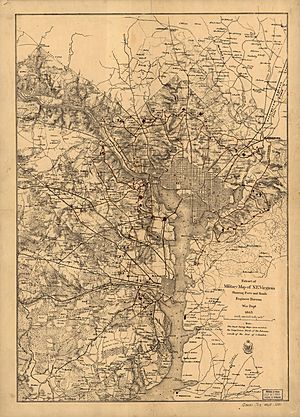Fort Worth (Virginia) facts for kids
Quick facts for kids Fort Worth |
|
|---|---|
| Part of the Civil War defenses of Washington, D.C. | |
| Alexandria, Virginia | |
| Coordinates | 38°48′54″N 77°05′56″W / 38.815°N 77.099°W |
| Type | Earthwork fort |
| Site information | |
| Controlled by | Union Army |
| Condition | Dismantled |
| Site history | |
| Built | 1861 |
| Built by | U.S. Army Corps of Engineers |
| In use | 1861–1865 |
| Materials | Earth, timber |
| Demolished | 1865 |
| Battles/wars | American Civil War |
Fort Worth was a strong fort built from timber (wood) and earth (dirt). It was located west of Alexandria, Virginia. This fort was an important part of the defenses for Washington, D.C. during the American Civil War.
The fort was built quickly after the Union forces lost the First Battle of Bull Run. Fort Worth sat on a hill north of Hunting Creek and Cameron Run. From this high spot, the fort could watch over important routes. These included the Orange and Alexandria Railroad and the Little River Turnpike. It also guarded the southern ways into Alexandria, which was the biggest city in Union-controlled Northern Virginia. Today, the site of Fort Worth is still in Alexandria. A street called Fort Worth Ave is near where the fort once stood.
The fort was named after a person named William Jenkins Worth.
Contents
Why Alexandria Was Occupied
The Union Army took control of Northern Virginia mostly without fighting. However, the town of Alexandria was different. There, a Union officer named Colonel Elmer E. Ellsworth went to a hotel. He wanted to take down a Confederate flag flying there. James Jackson, the hotel owner, shot and killed Ellsworth. Ellsworth was one of the first soldiers to die in the American Civil War. Because of this event, Alexandria remained loyal to the Confederate side. This meant the Union Army had to keep soldiers there throughout the war.
Protecting Washington D.C. with Forts
After the Union Army took over Northern Virginia, they built forts. These forts were placed along the Potomac River. They also guarded the three main bridges connecting Virginia to Washington and Georgetown. These bridges were the Chain Bridge, Long Bridge, and Aqueduct Bridge.
While these river forts were being built, plans began for a huge ring of new forts. These new forts would protect Washington D.C. from all directions. They would not just guard the direct routes through Arlington. In mid-July, this building work stopped because of the First Battle of Bull Run. Soldiers who were building forts had to go fight instead. After the Union lost at Bull Run, people panicked. They quickly built temporary trenches and earthworks. These were mostly in Arlington and near Washington.
On July 26, 1861, Maj. Gen. George B. McClellan became the commander of the Washington military area. He later led the Army of the Potomac. When McClellan arrived, he was shocked by how weak the city's defenses were. He said there was "nothing to prevent the enemy shelling the city."
To fix this, McClellan ordered a huge expansion of Washington's defenses. Forts and trenches would be built everywhere. They needed to be strong enough to stop any attack. Alexandria was especially important. It had a major port and was a key location.
Building Fort Worth
In August 1861, General McClellan put General John G. Barnard in charge. Barnard's job was to create a full system of defenses.
General Horatio Wright and General John Newton helped supervise the building. Wright oversaw Fort Ellsworth, and Newton managed forts south of Four Mile Run. They made sure men and materials were available.
Fort Worth was built on land taken from the Fairfax family. This land was part of a plantation called Vaucluse.
Construction started on September 1, 1861. The fort's outer edge was 463 yards long. It had space for 25 guns, including a powerful 100-pound Parrott rifle.
Fort Worth During the War
On November 27, 1861, Colonel J. Howard Kitching and his soldiers arrived. They were from the 6th New York Artillery. Their job was to occupy Fort Worth and finish building it.
Colonel Kitching wrote a letter describing their move. He said they had to leave their comfortable quarters at Fort Ellsworth. They marched to Fort Worth, which was still unfinished. Instead of training with guns, they had to use axes and shovels to work on the fort. He described the mud and cold, and how they had to set up a small stove in their tent. He also mentioned how hard it was to get a good meal.
On January 17, 1862, Kitching's troops moved again. They went to Fort Blenker. He wrote that they had to quickly tear down their winter quarters at Fort Worth. They left their log cook-houses and stables. Then they marched to their new post.


